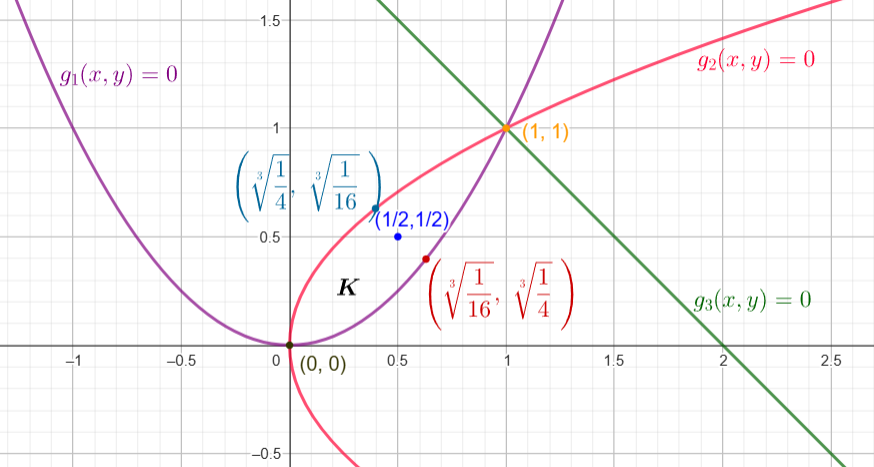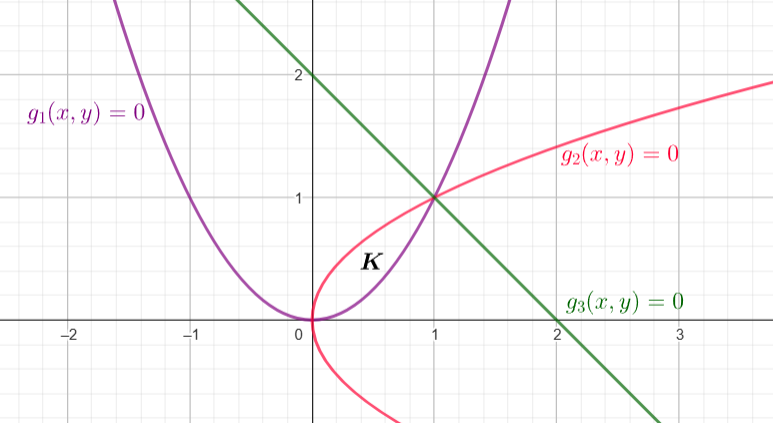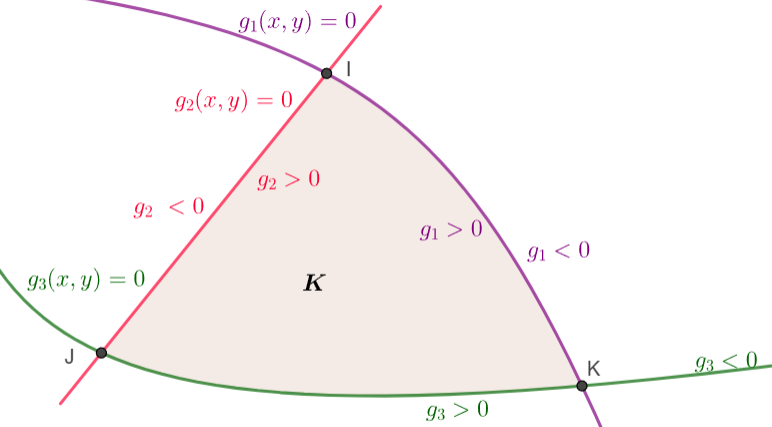En la entrada anterior revisamos varios ejemplos. Puedes hacer click en el siguiente enlace para revisarlos https://blog.nekomath.com/64-material-en-revision-teorema-de-la-funcion-implicita-1ra-version-lunes-28-de-octubre/?preview_id=101397&preview_nonce=90e45cbcb8&preview=true
Ahora veamos la demostración de este teorema.
Demostración:
(primera parte)
Sea $m = F_y (x_0, y_0) \neq 0$
$F_y (x, y) $ es continua en $(x_0, y_0).$
CASO 1: $m > 0$
Sea $\epsilon = \dfrac{m}{2}$ entonces , existe $ \delta > 0$ tal que para todo $(x, y) \in B_{\delta} (x_0, y_0)$ se cumple que
$\Big| \dfrac{\partial F}{\partial x} (x_0, y_0) \, – \, \dfrac{\partial F}{\partial y} (x_0, y_0) \Big| < \epsilon = \dfrac{m}{2}$
$ \Rightarrow \; \Big| \dfrac{\partial F}{\partial x} (x, y) \, – \, m \Big| < \dfrac{m}{2}$
$ \Rightarrow \; – \, \dfrac{m}{2} < \dfrac{\partial F}{\partial x} (x, y) \, – \, m < \dfrac{m}{2} $
$ \Rightarrow \; m \, – \, \dfrac{m}{2} < \dfrac{\partial F}{\partial x} (x, y) < m \, + \, \dfrac{m}{2} $
$ \Rightarrow \; \dfrac{m}{2} < \dfrac{\partial F}{\partial x} (x, y) < \dfrac{3m}{2} $
Por lo tanto $ \dfrac{\partial F}{\partial x} (x, y) > 0$
CASO 2: $m < 0$
Sea $\epsilon = – \, \dfrac{m}{2}$ entonces , existe $ \delta > 0$ tal que para todo $(x, y) \in B_{\delta} (x_0, y_0)$ se cumple que
$\Big| \dfrac{\partial F}{\partial x} (x_0, y_0) \, – \, \dfrac{\partial F}{\partial y} (x_0, y_0) \Big| < \epsilon = \, – \, \dfrac{m}{2}$
$ \Rightarrow \; \Big| \dfrac{\partial F}{\partial x} (x, y) \, – \, m \Big| < \, – \, \dfrac{m}{2}$
$ \Rightarrow \; \dfrac{m}{2} < \dfrac{\partial F}{\partial x} (x, y) \, – \, m < \, – \, \dfrac{m}{2} $
$ \Rightarrow \; m \, + \, \dfrac{m}{2} < \dfrac{\partial F}{\partial x} (x, y) < m \, – \, \dfrac{m}{2} $
$ \Rightarrow \; \dfrac{3m}{2} < \dfrac{\partial F}{\partial x} (x, y) < \dfrac{m}{2} $
Por lo tanto $ \dfrac{\partial F}{\partial x} (x, y) < \dfrac{m}{2} < 0$
Consideremos un rectángulo $\mathcal{R} $ tal que
$\mathcal{R} = \big[ x_0 \, – \, \alpha , x_0 \, + \, \alpha \big] \times \big[ y_0 \, – \, \beta , y_0 \, + \, \beta \big] \subseteq B_{\delta} (x_0, y_0)$
$\dfrac{\partial F}{\partial x} $ es continua en $\mathcal{R} $ compacto por lo que sabemos que está acotada.
Entonces, para todo $(x, y) \in \mathcal{R} $ se cumple que
$\Big| \dfrac{\partial F}{\partial x} (x, y) \Big| \leq M$
Si demostramos que para cada $ x_1 \in \big[ x_0 \, – \, \alpha , x_0 \, + \, \alpha \big]$
CASO I: $ F ( x_1, y_0 \, – \, \beta) < 0 $, y
CASO II: $ F ( x_1, y_0 \, + \, \beta) < 0 $
La continuidad de $ F $ nos dirá que existe un punto $\beta*$ tal que $ F ( x_1 , \beta* ) = 0 $
Consideremos la función $ g : \big[ y_0 \, – \, \beta , y_0 \, + \, \beta \big] \rightarrow \mathbb{R}$ , donde $ g (y) = F ( x_1 , y)$
Entonces $ F $ continua en $\mathcal{R}$ implica $g $ continua en $\big[ y_0 \, – \, \beta , y_0 \, + \, \beta \big]$ , por lo tanto, $ g (y) $ es única.
Si tomamos $ (x_1, , y) \in \mathcal{R} $ entonces $ \dfrac{\partial F}{\partial y} (x_1 , y) \neq 0$
En el caso de que $ \dfrac{\partial F}{\partial y} (x_1 , y) > 0 $ CASO I.
Caso 1: $ F_y (x_0, y_0)$
Sea $ m = F_y (x_0, y_0) $
$F_y $ es continua entonces, para $\epsilon = \dfrac{m}{2}$ existe $\delta > 0 $ tal que $ (x, y) \in B_{\delta} (x_0, y_0) $ implica que
$\Big| F_y (x , y ) \, – \, F_y (x_0, y_0) \Big| < \dfrac{m}{2}$
Esto implica que existe un rectángulo
$\mathcal{R}_1 = \big[ x_0 \, – \, {\alpha}_1 , x_0 \, + \, {\alpha}_1 \big] \times \big[ y_0 \, – \, \beta , y_0 \, + \, \beta \big] \subseteq B_{\delta} (x_0, y_0) $ tal que $(x, y) \in \mathcal{R}_1 $ implica $ F_y (x, y) > \dfrac{m}{2}$
Lema:
Existe un rectángulo $\mathcal{R}_1 = \big[ x_0 \, – \, {\alpha}_1 , x_0 \, + \, {\alpha}_1 \big] \times \big[ y_0 \, – \, \beta , y_0 \, + \, \beta \big] \subseteq \mathcal{R}_1$ tal que
(a) $ F ( x, y_0 \, – \, \beta) < 0 $ y
(b) $ F (x, y_0 \, + \, \beta) > 0 $
Además, en $\mathcal{R}_1$, que es un conjunto compacto, $F_x$ es continua y está acotada, es decir, existe $M > 0 $ tal que $\Big| F_x (x, y) \Big| \leq M $ para todo $ (x, y) \in \mathcal{R}_1$
Para garantizar la desigualdad (b)
$ F (x, y_0 \, + \, \beta) > 0$ empezamos con $ F (x, y_0 \, + \, \beta) $, luego
$ F (x, y_0 \, + \, \beta) = F (x, y_0 \, + \, \beta) \, – \, F (x, y_0) \, + \, F (x, y_0 )$
Entonces $F (x, y_0 \, + \, \beta) = F_y ( x, \eta) \beta \, + \, F (x, y_0)$ , como $ m = F_y (x_0, y_0) > 0$
$F_y ( x, \eta) > \dfrac{m}{2}$
$F_y ( x, \eta) \beta > \dfrac{m}{2} \beta $
$F_y ( x, \eta) \beta \, + \, F (x, y_0) > \dfrac{m}{2} \beta \, + \, F (x, y_0) $ . . . (1)
pero $ F (x, y_0) = F (x, y_0) \, – \, F(x_0, y_0)$, además $ F(x_0, y_0) = 0$ por hipótesis.
Tomemos $ 0 < \alpha < {\alpha}_1$, $(x, y) \in \mathcal{R}$
entonces $F (x, y_0) = F ( \xi , y_0) \alpha $
$ F (x, y_0) = \Big| F ( \xi , y_0) \Big| \alpha \leq M \alpha $
entonces
$ – \, M \alpha \leq F (x, y_0) \leq M \alpha $ . . . (2)
Sustituyendo (2) en (1) tenemos que
$F_y ( x, \eta) \beta \, + \, F (x, y_0) > \dfrac{m}{2} \beta \, + \, F (x, y_0) \geq \dfrac{m}{2} \beta \, – \, M \alpha$
si $\alpha $ es suficientemente pequeño
$\dfrac{m}{2} \beta \, – \, M \alpha > 0 \; \iff \; \dfrac{m}{2} \beta > M \alpha \; \iff \; \dfrac{m \beta}{2 M} > \alpha$
Luego $ \alpha = mín \Big\{ {\alpha}_1 , \dfrac{m \beta}{2 M} \Big\}$
entonces $ (x, y) \in \mathcal{R} $ garantiza la desigualdad (b).
Para la desigualdad (a)
$ F ( x, y_0 \, – \, \beta) < 0 $
empezamos con $ F (x, y_0 \, – \, \beta) $, luego
$ F (x, y_0 \, – \, \beta) = F (x, y_0 \, – \, \beta) \, – \, F (x, y_0) \, + \, F (x, y_0 )$
Entonces $F (x, y_0 \, – \, \beta) = \, – \, \Big(F (x, y_0 ) \, – \, F(x, y_0 \, – \, \beta) \Big) \, + \, F (x, y_0) = \, – \, F_y ( {\eta}’) \beta \, + \, F (x, y_0),$ como $ m = F_y (x, {\eta}’) > \dfrac{m}{2}$
$F_y ( x, {\eta}’) \beta > \dfrac{m}{2} \beta $
$\, – \, F_y ( x, {\eta}’) \beta < \, – \, \dfrac{m}{2} \beta $
$\, – \, F_y ( x, {\eta}’) \beta \, + \, F(x, y_0) < \, – \, \dfrac{m}{2} \beta \, + \, F(x, y_0)$
pero $ F(x, y_0) = F(x, y_0) \, – \, F(x_0 , y_0) = F_x ({\xi}’, y_0) (x \, – \, x_0)$
entonces $ \Big| F(x, y_0) \Big| = \Big| F_x ({\xi}’, y_0) \Big| \Big| (x \, – \, x_0) \Big| \leq M \alpha$ implica $ F (x, y_0) \leq M \alpha.$
Por lo tanto
$\, – \,F_y ( x, {\eta}’) \beta \, + \, F (x, y_0) < \, – \, \dfrac{m}{2} \beta \, + \, F (x, y_0) \leq \, – \, \dfrac{m}{2} \beta \, + \, M \alpha < 0,$ si y solo si
$ M \alpha < \dfrac{m}{2} \beta \; \iff \; \alpha < \dfrac{m \beta}{2 M} $
entonces $ (x, y) \in \mathcal{R} $ garantiza la desigualdad (a) y con esto queda demostrado el lema.
Regresando a la demostración del teorema, gracias al lema, sabemos que
para cada $ x \in \big[ x_0 \, – \, {\alpha}_1 , x_0 \, + \, {\alpha}_1 \big] $ existe alguna $y^*$ tal que $ y^* \in \big[ y_0 \, – \, {\beta} , y_0 \, + \, \beta \big] $ y $ F (x, y^*) = 0$.
Veamos que $y^*$ es único.
Consideremos $g (y) = F (x, y)$ y fijando $x$ tenemos que
$g’ (y) = F_y (x, y) > \dfrac{m}{2} > 0$ , para toda $ y \in \big[ y_0 \, – \, {\beta} , y_0 \, + \, \beta \big]$
entonces $ g $ es estrictamente creciente, $ g $ es inyectiva, y por lo tanto $y^*$ es única.
Entonces para cada $x \in \big[ x_0 \, – \, {\alpha} , x_0 \, + \, \alpha \big]$ existe un único $y \in \big[ y_0 \, – \, {\beta} , y_0 \, + \, \beta \big].$
Tenemos una función $ f : \big[ x_0 \, – \, {\alpha} , x_0 \, + \, \alpha \big] \rightarrow \big[ y_0 \, – \, {\beta} , y_0 \, + \, \beta \big] $ donde cada $ x \rightarrow y^*$ tal que $ F ( x , f (x) ) = 0$.
Ahora veamos que $y = f (x)$ es continua, derivable y la derivada es $f’ (x) = \, – \, \dfrac{f_x (x, f (x) )}{f_y (x, f (x) )}$ para todo $ x \in \big[ x_0 \, – \, {\alpha} , x_0 \, + \, \alpha \big]$
Para ver que $ f $ es continua en $ x \in \big[ x_0 \, – \, {\alpha} , x_0 \, + \, \alpha \big]$.
Consideremos la diferencia $ f (x + h) \, – \, f (x) $ para algún $ h $ suficientemente pequeña.
Sea $\mathcal{K} = f (x + h) \, – \, f (x) $
Aplicamos el teorema del valor medio para la derivada a $F : A \subseteq \mathbb{R}^2 \rightarrow \mathbb{R}$
$(x_0. y_0) \in \mathcal{R} \subseteq A$ donde $\mathcal{R}$ rectángulo, que es convexo,
entonces $F ( x \, + \, h, y \, + \, k ) \, – \, F ( x , y) = \dfrac{\partial F}{\partial x} ( x + \theta h , y + \theta k) h \, + \, \dfrac{\partial F}{\partial y} ( x + \theta h , y + \theta k) k$ para alguna $\theta \in [0, 1]$
pero $ y = f (x) $, y además $ y + k = f (x + h) + f (x) \, – \, f (x) = f ( x + h)$
entonces $F ( x \, + \, h, y \, + \, k ) = F ( x \, + \, h, f (x + h) ) = 0 $ por la definición de $f$.
Entonces $F (x, y) = F (x , f (x) ) = 0$
Entonces de
$ \dfrac{\partial F}{\partial x} ( x + \theta h , y + \theta k) h \, + \, \dfrac{\partial F}{\partial y} ( x + \theta h , y + \theta k) k = 0$
$\dfrac{\partial F}{\partial x} ( x + \theta h , y + \theta k) h = \, – \, \dfrac{\partial F}{\partial y} ( x + \theta h , y + \theta k) k$
$\dfrac{k}{h} = \dfrac{ – \, \dfrac{\partial F}{\partial x} }{ \dfrac{\partial F}{\partial y}}$
entonces
$\dfrac{ f (x + h) \, – \, f (x) }{h} = \dfrac{ – \, \dfrac{\partial F}{\partial x} }{ \dfrac{\partial F}{\partial y}}$
entonces
$\lim\limits_{h \to 0} \dfrac{ f (x + h) \, – \, f (x) }{h} = \, – \, \lim\limits_{h \to 0} \dfrac{F_x ( x + \theta h , y + \theta k)}{F_y ( x + \theta h , y + \theta k)}$
$f’ (x) = \, – \, \dfrac{ F_x (x, y)}{ F_y (x, y)}$
Un detalle: ver por qué $ k \rightarrow 0$ cuando $ h \rightarrow 0$ es decir que
$f ( x + h) \, – \, f (x) \rightarrow 0$
Es decir, por demostrar, $ f $ es continua.
Veamos que $f$ es continua en $ x \in \big[ x_0 \, – \, \alpha, x_0 \, + \, \alpha\big]$
$\mathcal{K} = f (x + h) \, – \, f (x) = \, – \, \dfrac{F_x}{F_y} h$
$\big| \mathcal{K} \big| = \, – \, \dfrac{\big| F_x \big|}{ \big| F_y \big|} \big| h \big| \leq \dfrac{ M \big| h \big|}{F_y} \leq \dfrac{M \big| h \big|}{N}$ . . . (3)
La última desigualdad se cumple si y solo si
$\dfrac{1}{F_y} \leq \dfrac{1}{N} \; \iff \; N \leq \big| F_y \big|$ pero además $ \big| F_y \big| > \dfrac{m}{2}$
por lo tanto nos sirve $ N = \dfrac{m}{2}$
Luego, de (3) podemos concluir que $ f $ es continua. $_{\blacksquare}$
Una última observación:
Si $\dfrac{\partial F}{\partial y} (x_0, y_0) < 0 $ entonces $\dfrac{\partial}{\partial y} (\, – \, F) (x_0, y_0) > 0$, consideramos $ G = \, – \, F$



